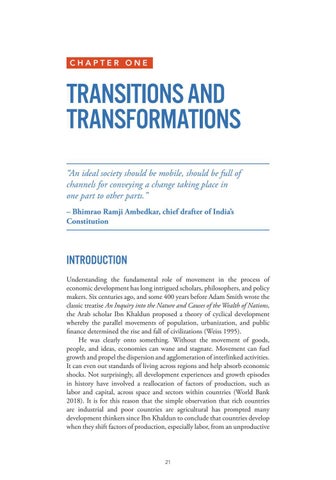CHAPTER ONE
TRANSITIONS AND TRANSFORMATIONS “An ideal society should be mobile, should be full of channels for conveying a change taking place in one part to other parts.” – Bhimrao Ramji Ambedkar, chief drafter of India’s Constitution
INTRODUCTION Understanding the fundamental role of movement in the process of economic development has long intrigued scholars, philosophers, and policy makers. Six centuries ago, and some 400 years before Adam Smith wrote the classic treatise An Inquiry into the Nature and Causes of the Wealth of Nations, the Arab scholar Ibn Khaldun proposed a theory of cyclical development whereby the parallel movements of population, urbanization, and public finance determined the rise and fall of civilizations (Weiss 1995). He was clearly onto something. Without the movement of goods, people, and ideas, economies can wane and stagnate. Movement can fuel growth and propel the dispersion and agglomeration of interlinked activities. It can even out standards of living across regions and help absorb economic shocks. Not surprisingly, all development experiences and growth episodes in history have involved a reallocation of factors of production, such as labor and capital, across space and sectors within countries (World Bank 2018). It is for this reason that the simple observation that rich countries are industrial and poor countries are agricultural has prompted many development thinkers since Ibn Khaldun to conclude that countries develop when they shift factors of production, especially labor, from an unproductive
21



